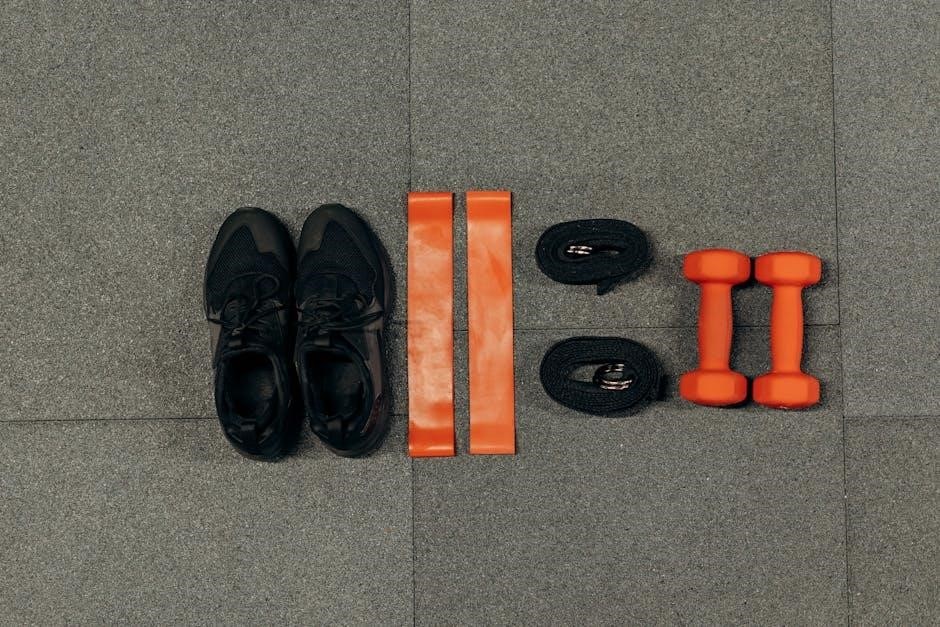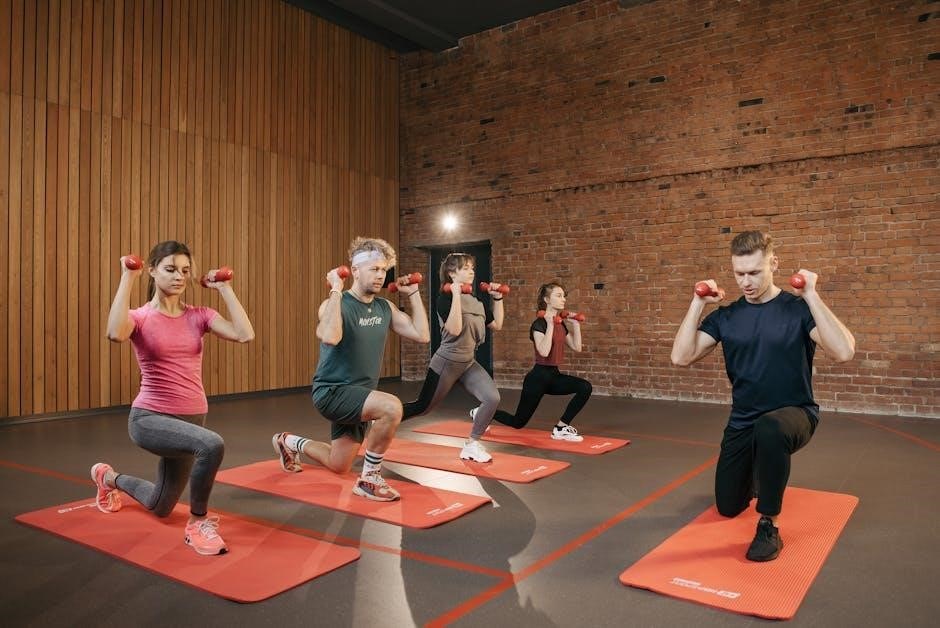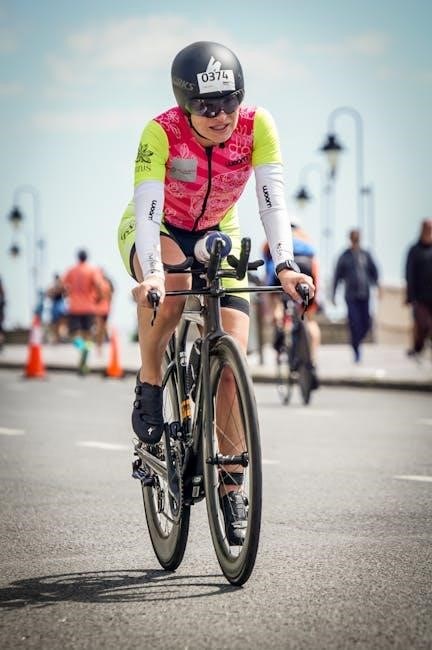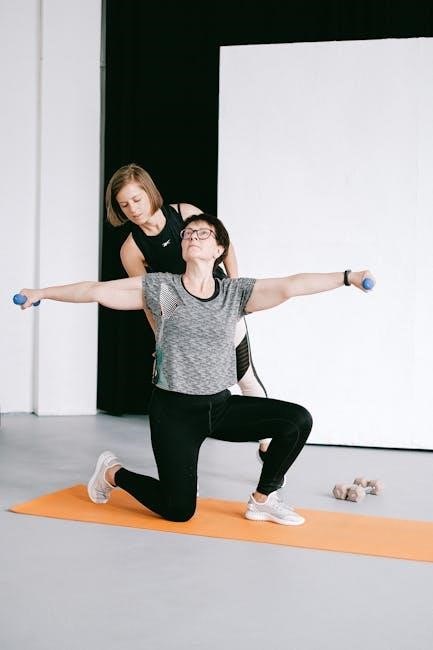A well-structured IRONMAN 70.3 training program is essential for athletes aiming to complete a 1.2-mile swim, 56-mile bike, and 13.1-mile run. These plans, often available as free or paid PDF downloads, are designed to gradually build endurance, speed, and race-specific skills over 12 to 24 weeks. Coaches like Marilyn Chychota offer tailored plans for novice, intermediate, and advanced athletes, focusing on balanced training, recovery, and mental preparation to ensure peak performance on race day.
1.1 What is an IRONMAN 70.3?
An IRONMAN 70.3, also known as a half-Ironman, is a triathlon consisting of a 1.2-mile swim, 56-mile bike ride, and 13.1-mile run. It is a challenging middle-distance event that tests endurance, stamina, and mental toughness. The name “70.3” refers to the total distance in miles, making it half the distance of a full IRONMAN. This event is a significant milestone for triathletes, requiring a well-structured training program to ensure proper preparation and peak performance on race day.
1.2 Importance of a Structured Training Plan
A structured training plan is crucial for progressing safely and effectively toward an IRONMAN 70.3. It ensures consistent improvement, prevents overtraining, and builds specific skills needed for race day. A well-designed plan allows for customization to suit individual goals and fitness levels, while race-specific workouts and recovery strategies help athletes peak at the right time. Guidance from experienced coaches, like Marilyn Chychota, further enhances preparation, making a structured plan indispensable for success in this demanding event.
1.3 Key Components of a 70.3 Training Program
A comprehensive IRONMAN 70.3 training program includes structured swim, bike, and run workouts, with progressive overload to build endurance and speed. It incorporates periodized phases, race-specific sessions, and recovery strategies. Nutrition and hydration planning are also critical, along with mental preparation techniques. Each component is designed to ensure athletes peak for race day, with customizable plans catering to individual fitness levels and goals, as outlined in detailed PDF guides and expert coaching resources.

Understanding the Distance and Requirements
An IRONMAN 70.3 consists of a 1.2-mile swim, 56-mile bike ride, and 13.1-mile run. Each segment demands specific skills and endurance, with the swim in open water, bike on varied terrain, and run testing stamina after two prior efforts.
2.1 Swim: 1.2 Miles (1.9 km)
The swim segment of an IRONMAN 70.3 is 1.2 miles or 1.9 kilometers, typically in open water, requiring strong endurance and technique. Training plans often include interval workouts, drills, and long swims to build stamina. Open-water simulations help athletes adapt to variable conditions. Proper pacing and sighting are crucial to maintain efficiency. Incorporating strength training for shoulders and core can enhance performance. A well-structured swim program ensures athletes are race-ready, capable of completing this challenging segment confidently.
2.2 Bike: 56 Miles (90 km)
The bike segment of an IRONMAN 70.3 is 56 miles or 90 kilometers, requiring a combination of endurance, pacing, and strategy. Training plans emphasize building bike-specific endurance through long rides, interval workouts, and cadence drills. Incorporating brick sessions (bike-to-run transitions) helps simulate race conditions. Proper pacing and nutrition are critical to avoid fatigue. Athletes often focus on maintaining consistent power output and optimizing bike fit for efficiency; This segment is a pivotal part of the race, demanding both physical and mental resilience.
2.3 Run: 13.1 Miles (21.1 km)
The 13.1-mile run is the final challenge, requiring endurance, pacing, and mental strength. Training involves interval workouts, long runs, and brick sessions to build stamina. Athletes focus on maintaining consistent pacing and practicing race-specific nutrition strategies. Mental resilience is key to pushing through fatigue. Proper hydration and fueling are emphasized to sustain energy levels. Consistent training helps adapt to the demands of the distance, ensuring a strong finish.

Choosing the Right Training Plan
Selecting the right IRONMAN 70.3 training plan depends on your fitness level and goals. Options include 12-, 16-, or 20-week plans, offering flexibility for novice to advanced athletes. Customizable plans allow you to balance training with daily life, ensuring steady progress toward race day. Coaches like Marilyn Chychota provide structured guidance to maximize potential and avoid overtraining, helping you prepare effectively for the demands of the event.
3.1 12-Week Training Plan
A 12-week IRONMAN 70.3 training plan is ideal for athletes with a solid fitness base, targeting intermediate triathletes. It assumes you can swim 2000m, bike for 2.5 hours, and run for 75 minutes. The plan progresses through base, build, and peak phases, with three swims, bikes, and runs weekly. Strength sessions are included to enhance endurance and power. This structured approach ensures gradual progression, avoiding overtraining while building race-specific skills for optimal performance on event day.
3.2 16-Week Training Plan
A 16-week IRONMAN 70.3 training plan offers a more gradual approach, ideal for athletes needing extra time to build endurance. Starting with foundational aerobic workouts, the plan progresses through base, build, and peak phases. It includes three swims, three bikes, and three runs per week, with strength sessions to enhance performance. This extended timeline allows for better adaptation and reduces injury risk, ensuring athletes are fully prepared for the demands of race day.
3.3 20-Week Training Plan
A 20-week IRONMAN 70.3 training plan is designed for novice triathletes, starting with foundational fitness and progressing to race readiness. It includes three swims, three bike sessions, and three runs weekly, plus strength training. The plan is divided into base, build, and peak phases, focusing on gradual endurance development, speed, and race-specific skills. This extended timeline ensures a balanced approach, reducing injury risk and building confidence for the 70.3 event.
3.4 Customizing the Plan for Individual Needs
A 20-week IRONMAN 70.3 training plan can be tailored to fit individual needs, ensuring progression from foundational fitness to race readiness. The plan includes three swims, three bike sessions, and three runs weekly, plus strength training. It is divided into base, build, and peak phases. Suitable for novices, the plan emphasizes gradual endurance development and race-specific skills. Coaches adapt workouts based on fitness levels and goals, ensuring a balanced approach to training and recovery.

Phases of Training
IRONMAN 70.3 training programs are divided into three phases: base, build, and peak. Each phase focuses on building endurance, increasing intensity, and race-specific preparation to ensure optimal race readiness.
4.1 Base Phase: Building Aerobic Endurance
The base phase focuses on establishing a strong aerobic foundation through consistent, moderate-intensity workouts. Athletes engage in regular swim, bike, and run sessions, with gradual increases in volume. This period emphasizes building endurance and stamina, preparing the body for more intense training later. Strength and conditioning exercises are also incorporated to improve overall resilience and prevent injuries, ensuring a solid platform for progression in subsequent phases.
4.2 Build Phase: Increasing Intensity
The build phase shifts focus from aerobic endurance to increasing intensity, introducing race-specific workouts. Athletes incorporate tempo runs, interval training, and high-cadence bike sessions to enhance speed and power. Swim workouts include pace-based intervals to simulate race conditions. Strength sessions are maintained to support muscular endurance. This phase prepares athletes for the demands of race day by balancing intensity with strategic recovery, ensuring they peak at the right time while avoiding overtraining risks. Consistency and precision are key during this period.
4.3 Peak Phase: Race-Specific Preparation
The peak phase focuses on race-specific preparation, with workouts mimicking race conditions. Athletes engage in brick sessions, combining bike-to-run transitions, and race-pace simulations. Swim, bike, and run intensities are refined to mirror race-day efforts. Taper strategies reduce training volume to ensure recovery while maintaining sharpness. This phase fine-tunes race readiness, allowing athletes to adapt to the demands of the 70.3 distance and maximize performance on race day through targeted and precise training.

Weekly Training Structure
A balanced mix of swim, bike, and run sessions, with dedicated strength and conditioning workouts. Structured to include rest days and progression, tailored to individual needs for optimal performance.
5.1 Swim Workouts: Frequency and Progression
Swim workouts occur 3-4 times weekly, focusing on endurance, speed, and technique. Sessions include interval training, pull sets, and race-specific drills. Progression involves increasing distance and intensity gradually, ensuring adaptation. Rest intervals and pacing strategies are emphasized to build stamina. Technique refinement, such as stroke efficiency, is integrated to enhance performance. These structured workouts prepare athletes for the 1.2-mile swim segment, ensuring confidence and readiness on race day.
5.2 Bike Workouts: Building Endurance and Speed
Bike workouts focus on endurance and speed, typically 3-4 times weekly. Sessions include long steady rides, interval training, and race-pace simulations. Progression involves increasing distance and intensity to build stamina. Structured workouts like tempo rides and hill repeats enhance cardiovascular fitness and leg strength. These sessions prepare athletes for the 56-mile bike segment, ensuring they can maintain a strong pace and transition smoothly to the run.
5.3 Run Workouts: Endurance and Pace
Run workouts focus on building endurance and maintaining a consistent pace, typically 3 times weekly. Sessions include long slow distance runs, interval training, and tempo runs to enhance cardiovascular fitness and muscular endurance. Progression involves increasing mileage and intensity to prepare for the 13.1-mile run. Race-pace simulations and brick sessions are incorporated to improve transition readiness and mental resilience, ensuring athletes can sustain their target pace on race day.
5.4 Strength and Conditioning
Strength and conditioning workouts are vital for improving durability, power, and overall performance. These sessions focus on core stability, functional movements, and injury prevention exercises. Typically performed 1-2 times weekly, they complement swim, bike, and run training without overlapping. Exercises like squats, lunges, and planks are common, with progressive overload to build strength. Consistency in these workouts enhances muscular endurance and resilience, directly benefiting race performance and reducing injury risk. They are tailored to fit within the overall training plan.

Race-Specific Workouts
Race-specific workouts, like brick sessions and race pace simulations, are designed to mimic race-day conditions. These sessions build race readiness and mental toughness, ensuring athletes are prepared for the demands of the IRONMAN 70.3 event.
6.1 Brick Sessions
Brick sessions involve back-to-back bike and run workouts, simulating race-day transitions. These sessions enhance endurance, reduce muscle fatigue, and improve mental adaptability. Athletes can perform short or long bricks, varying intensity and duration to build race-specific fitness. Incorporating bricks into training helps bridge the gap between disciplines, ensuring a smoother transition on race day. Regular brick workouts are crucial for IRONMAN 70.3 success, fostering overall race readiness and confidence.
6.2 Race Pace Simulations
Race pace simulations are structured workouts mirroring the intensity and conditions of race day. These sessions help athletes gauge and maintain their target pace while building mental and physical resilience. By incorporating race-specific efforts into training, triathletes refine their pacing strategy, optimize endurance, and enhance overall race readiness. Regular simulations ensure athletes are well-prepared to execute their race plan effectively and confidently on event day, making them a crucial component of a successful IRONMAN 70.3 training program.

Nutrition and Hydration
Nutrition and hydration are critical for optimizing performance and recovery in IRONMAN 70.3 training. A balanced diet, proper fueling during workouts, and strategic hydration ensure sustained energy levels and peak physical condition, enabling athletes to train effectively and prepare for race day.
7.1 Fueling for Workouts
A balanced diet rich in carbohydrates, lean proteins, and healthy fats is essential for IRONMAN 70.3 training. Carbohydrates provide energy, while proteins support muscle repair. Proper hydration, including electrolytes, is crucial to prevent dehydration and cramps. Fueling 2-3 hours before workouts with easily digestible foods ensures energy availability. During long sessions, consume carbohydrates and electrolytes regularly to sustain performance. Avoid heavy meals close to workouts to prevent discomfort and optimize absorption.
7.2 Hydration Strategies
Proper hydration is critical for endurance in IRONMAN 70.3 training. Aim to drink 16-20 ounces of fluid 1-2 hours before workouts. Monitor urine color for hydration levels; pale yellow indicates optimal hydration. During long sessions, consume electrolyte-rich drinks to maintain sodium balance and prevent cramps. Replenish fluids post-workout to aid recovery. Adjust hydration intake based on sweat rate and weather conditions to avoid dehydration and optimize performance throughout training.
7.4 Race Day Nutrition Plan
A race day nutrition plan ensures optimal energy levels throughout the IRONMAN 70.3 event. Consume a balanced, high-carb meal with lean protein 1-3 days before the race. On race morning, eat a light, easily digestible breakfast 2-3 hours prior to the start. During the race, fuel with energy gels, electrolytes, and fluids at regular intervals to maintain energy and hydration. Post-race, replenish with a mix of carbs and protein to aid recovery and reduce muscle soreness.
Recovery and Rest
Recovery and rest are crucial for optimal performance. Incorporate rest days, active recovery techniques, and 7-9 hours of sleep to prevent injuries and enhance overall performance.
8.1 Importance of Rest Days
Rest days are crucial in any IRONMAN 70.3 training program, allowing the body to repair and adapt. Without adequate rest, athletes risk overtraining, injuries, and mental burnout. Rest enables muscle recovery, strengthens the immune system, and enhances overall performance; Neglecting rest can lead to decreased progress and increased fatigue. Incorporating scheduled rest days ensures long-term consistency and peak race readiness. They are as important as training itself for achieving optimal results.
8.2 Active Recovery Techniques
Active recovery involves low-intensity activities that promote muscle repair and maintain mobility. Swimming, cycling, and yoga are excellent options, as they reduce stiffness without overexertion. Foam rolling and stretching also aid in muscle recovery. These techniques enhance blood flow, reduce soreness, and prevent injury. Incorporating active recovery into your IRONMAN 70.3 training program ensures sustained progress and overall well-being, keeping you consistent and prepared for intense workouts.
8.3 Sleep and Recovery
Sleep is crucial for physical and mental recovery in IRONMAN 70.3 training. Aim for 7-9 hours nightly to aid muscle repair and cognitive function. Establish a consistent bedtime routine to improve sleep quality. A dark, quiet environment and avoiding screens before bed can enhance restfulness. Prioritizing sleep ensures better training consistency, injury prevention, and peak performance. It’s as vital as any workout in your training program, directly impacting your body’s ability to adapt and recover effectively.

Taper and Race Preparation
Tapering involves reducing training volume 1-2 weeks before race day to allow recovery. Focus on rest, strategic workouts, and mental preparation to ensure peak race readiness.
9.1 Reducing Volume Before Race Day
Reducing training volume 1-2 weeks before race day allows your body to recover and adapt. Focus on rest, strategic workouts, and race-specific sessions to maintain intensity without overloading. This period ensures you feel fresh and ready to perform at your best on race day, balancing rest with targeted preparation to avoid undertraining or burnout.
9.2 Taper Strategies
Implementing a structured taper strategy is crucial for peak race performance. Gradually reduce training volume while maintaining intensity to allow your body to recover and adapt. Incorporate rest days, shorter sessions, and race-specific workouts to stay sharp without overloading. This balanced approach ensures you arrive at race day feeling fresh, strong, and mentally prepared to tackle the IRONMAN 70.3 challenge effectively.
9.3 Final Preparations
Final preparations involve fine-tuning race strategies, checking gear, and ensuring nutrition and hydration plans are dialed in. Review the racecourse, visualize the event, and mentally rehearse transitions. Pack essential items like race attire, nutrition, and hydration gear. Stay hydrated, fuel adequately, and prioritize rest. Avoid new foods or activities that could disrupt race readiness. Focus on staying calm and confident, trusting the training completed. Stick to routines to maintain consistency and mental clarity leading up to race day.

Common Mistakes to Avoid
Common mistakes include overtraining, which can lead to injury or burnout, inadequate nutrition planning, and poor race-day strategy. Proper pacing and balanced training are crucial for success.
10.1 Overtraining
Overtraining is a common mistake that can derail an IRONMAN 70.3 preparation. It occurs when athletes exceed their body’s recovery capacity, leading to fatigue, decreased performance, and increased injury risk. Signs include persistent muscle soreness, insomnia, and lack of progress. To avoid this, ensure adequate rest days, monitor workload, and balance intensity with recovery. A structured training plan with built-in rest periods is essential to prevent overtraining and maintain consistent progress toward race day goals.
10.2 Inadequate Nutrition
Inadequate nutrition is a critical mistake that can hinder IRONMAN 70.3 performance. Many athletes overlook proper fueling, leading to low energy, fatigue, and poor recovery. A balanced diet rich in carbohydrates, protein, and fats is essential to sustain endurance and muscle repair. Additionally, hydration strategies must be prioritized to avoid dehydration and gastrointestinal issues. Practicing race-day nutrition during training ensures athletes can tolerate fuels and avoid digestive discomfort, optimizing performance and overall race readiness.
10.3 Poor Race Planning
Poor race planning is a common mistake that can derail an IRONMAN 70.3 performance. Many athletes fail to practice race-specific scenarios, such as transitions, fueling, and pacing. Without proper preparation, athletes may misjudge their race pace, leading to early exhaustion or poor time management. Additionally, neglecting to test equipment and clothing during training can result in discomfort or mechanical issues on race day, further complicating the athlete’s ability to perform at their best.

Mental Preparation
Mental preparation is crucial for IRONMAN 70.3 success, involving techniques like visualization, resilience-building, and maintaining a positive mindset. These strategies help athletes stay focused and motivated during intense training and race day challenges.
11.1 Building Mental Resilience
Building mental resilience is vital for IRONMAN 70.3 success. Techniques like visualization, positive self-talk, and mindfulness help athletes manage stress and stay focused. A growth mindset fosters adaptability, while breaking the race into smaller, manageable segments reduces overwhelm. Consistent mental drills and learning from setbacks strengthen emotional fortitude, enabling athletes to push through challenges and maintain confidence during training and race day.
11.2 Visualization Techniques
Visualization techniques are powerful tools for IRONMAN 70.3 athletes, enhancing mental preparation and race readiness. By vividly imagining race scenarios, athletes can build confidence, refine strategies, and mentally rehearse overcoming challenges. Regular visualization practice helps maintain focus, reduces race-day anxiety, and strengthens resilience. Athletes are encouraged to visualize themselves performing at their best, staying composed under pressure, and achieving their goals, fostering a positive mindset essential for peak performance. Consistency in this practice yields significant mental gains.
11;3 Race Day Mindset
A strong race day mindset is crucial for IRONMAN 70.3 success. Athletes should focus on staying present, maintaining confidence, and trusting their training. Positivity and resilience help navigate challenges, while a clear race strategy ensures composure under pressure. Managing expectations and embracing the journey fosters mental toughness. Visualization of success and adherence to race plans enhance performance, allowing athletes to execute their best effort and cross the finish line with pride, regardless of the outcome.
Completing an IRONMAN 70.3 training program is a remarkable achievement, requiring dedication, hard work, and belief in oneself. The journey to race day is a testament to your commitment and perseverance.
12.1 Final Tips for Success
Consistency is key—stick to your training plan and balance it with rest. Listen to your body to avoid injuries. Proper nutrition and hydration are crucial for optimal performance. Mental preparation, including visualization and positive mindset, will help you stay focused. Trust the process and believe in your training. Race day is the culmination of your hard work, so stay calm, enjoy the experience, and cross that finish line with pride!
12.2 Staying Motivated
Stay motivated by setting clear, achievable goals and celebrating small victories along the way. Surround yourself with a supportive community or training group to share experiences. Track your progress to see improvements, which boosts confidence. Remind yourself of your “why” and visualize crossing the finish line. Stay positive, embrace challenges as growth opportunities, and reward consistency. Mental resilience is just as important as physical training—keep pushing forward and believe in your journey!
